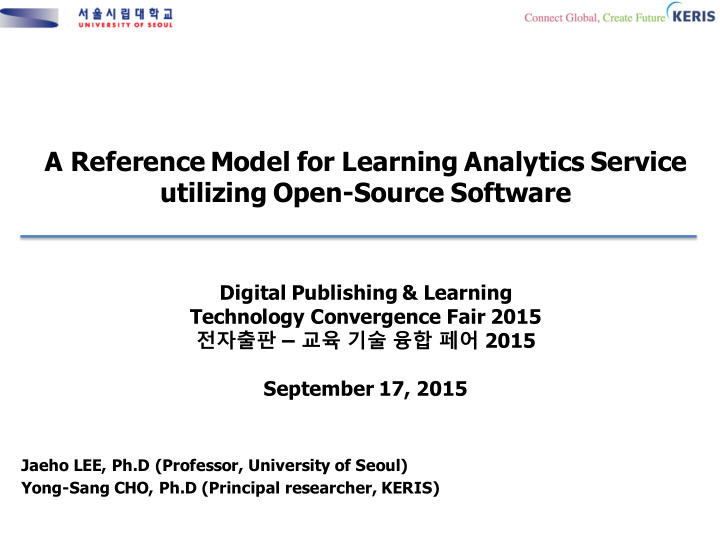



A Reference Model for Learning Analytics Service utilizing Open-Source Software Digital Publishing & Learning Technology Convergence Fair 2015 전자출판 – 교육 기술 융합 페어 2015 September 17, 2015 Jaeho LEE, Ph.D (Professor, University of Seoul) Yong-Sang CHO, Ph.D (Principal researcher, KERIS)
Table of Contents • What we know and what we don’t know • Case study for data flows and exchange - xAPI - IMS Caliper • Proof of Concept: reference model for learning analytics - Reference architecture for learning analytics service - System deployment using open source SW • Future works by 2016 • But, keep in mind
What we know is …
Source: Smart Devices & Cloud Computing http://www.exelanz.com/blogs/smart-devices-cloud-computing/
Learning applications creation/ classroom … eportfolio collaboration delivery ebook capture assessment http://developers.imsglobal.org/catalog.html
What we don’t know is …
Source: http://tincanapi.com/overview/ What to measure? How to collect? Is it connected to each other?
Questions expected from data mining & learning analytics Source: Collegestats.org http://collegestats.org/2013/01/how-can-data-mining-analytics-enhance-education/
Case Study to explore what we don’t know (Data flow and exchange)
xAPI Transcript/learning data can be delivered to LMSs, LRSs or reporting tools Experience data LMS: Learning Management System LRS: Learning Record Store
IMS Caliper Source: New Architect for Learning (Rob Abel, 2014) http://www.slideshare.net/JEPAslide/day3-edupub-tokyoims?qid=76ce5d4a-1ccf-468f-a428-c652584c395a&v=default&b=&from_search=4
http://www.coursesmart.com/go/institutions/analytic s
Proof of Concept: a reference model for learning analytics
We want to see the iceberg below to understand what we don’t know yet!!! To answer, • what is the general process for learning analytics? • do we need to define workflows beyond xAPI or IMS Caliper? • How do we prove the concept?
Step 1. design an reference architecture for learning analytics
Step 1. design a deployment architecture (in 2014) R Rstudio (Ploting Library) RImpala / RODBC JDBC / ODBC HIVE Impala Shell Cloudera Manager / HUE Client Metastore Cloudera Impala Cloudera Impala Cloudera Impala HBase HDFS HBase HDFS HBase HDFS
Step 1. design a deployment architecture (in 2015) R Visualization Tool (i.e. Chart.js) RImpala / RODBC JDBC / ODBC HIVE Tools for Triple Cloudera Manager / HUE Client Metastore i.e. GraphLab Cloudera Impala Cloudera Impala Cloudera Impala Mong Mong Mong o HDFS o HDFS o HDFS DB DB DB
Step 2. design an abstract workflow for the reference mode - Inforgraphics - Presentation - High Performance Distributed File Processing Tech (Hadoop) such as 3D and - Data Extracting and Filtering AR - LTI(Learning Tool Interoperability), IMS Caliper Data Store Learning Data & Analyzing Visualization Activity Collection Processing Policy Framework - Structured: DB, Spreadsheet, etc - Analytics Algorithm - Natural Language - Semi-structured: XML, HTML, etc (Schema based Markup) Processing, - Unstructured: Text, Image, Video, Voice Data, etc Emotion Analytics, etc - Data Masking - Analysis Algorithm Selection - Privacy Policy Implementaion
Step 2. design a workflow of the reference model v1.0
Step 2. design a workflow of the reference model v1.1 Intercode Readium Application Input Data Items for Learning Analytics Data Collection Application Learning Activity - Lecture (MOOCs, OER) Data - Material (reading etc) - Reading - Assessment Data Storing & - Learning tool - Lectures - Collaboratio Collection - Quiz/Assesment Item Processing - Quiz n Data Processing and Analytics - Discussion forum - Projects - Annotation - Message - Homewo - Gaming Secure Data Exchange - Social Network rk - Social Data Analysis - Prior Credit Application - Media - Messaging - Achievement Privacy - Tutoring - Scheduling - Systemo Log - Research - Discussions - …… Policy Personalization, Learning & Teaching Intervention and Activity Prediction, etc Visualizati Analyzing on Outcome from Learning Analytics Dashboard Web UI
Step 2. design a workflow of the reference model - data collection process
Step 2. design a workflow of the reference model - data storing/filtering process
Step 2. design a workflow of the reference model - analyzing process
Step 2. design a workflow of the reference model - visualization process
Step 3. design a scenario (Basic analytics process) 1. Student open digital textbook on Readium-JS viewer 2. Data is generated through reading activities by student 3. Data capture API crawl the data and send to event store 4. On the analytics platform check collected data 5. See simple dashboard from collected data (without analysis algorithm) (Advanced analytics process) 6. Design analysis algorithm with data filtering from collected data 7. See advanced dashboard pertaining to customized analysis 8. Calculate personal learning path connected to LOD for curriculum standard
DEMO
DEMO 1. open digital textbook on Readium-JS viewer Open sample digital textbook via Readium-JS Viewer
DEMO 2. Reading activities on Readium-JS viewer Capture the event for page view
Captured data in JSON format by sensor API Call send() function from Sensor API from Endpoint Result for event data capturing by sensor API: “result=SUCCESS”
DEMO 3. Reading activity data converted to the RDF format ViewEvent data in RDF format ViewEvent data in JSON format
DEMO 4. Collected data on event store
DEMO 5. Dashboard showing engagement profile
DEMO 5. Dashboard showing engagement profile
Future works by 2017
By February 2017 • Complete development for data capture API (beta version) - collaborate with IMS Global * to improve efficiency of data sharing format • Complete design and development for test-bed of reference model - complete tests for open source SWs to organize optimized composition - design interface for analysis algorithm based on R • Complete design for LOD of achievement standards - to connect digital resources with specific topics of curriculum standards * connected digital resources, ISO/IEC 19788 MLR will be used
But, keep in mind!
<Gartner Hype Cycle, 2014>
Thank You !!!
Recommend
More recommend